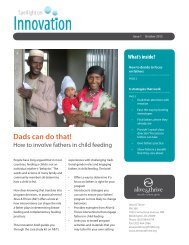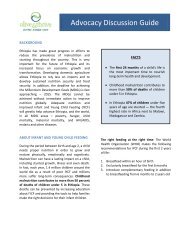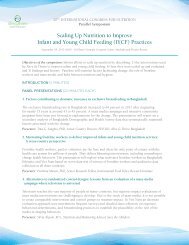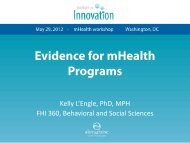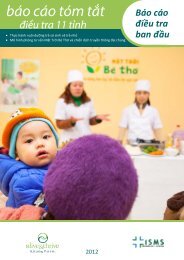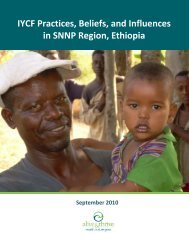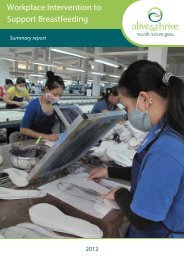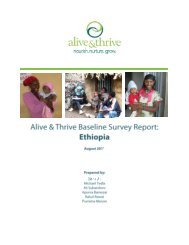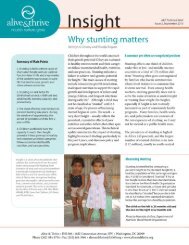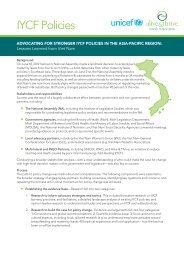IYCF Practices, Beliefs, and Influences in Tigray ... - Alive & Thrive
IYCF Practices, Beliefs, and Influences in Tigray ... - Alive & Thrive
IYCF Practices, Beliefs, and Influences in Tigray ... - Alive & Thrive
You also want an ePaper? Increase the reach of your titles
YUMPU automatically turns print PDFs into web optimized ePapers that Google loves.
Key F<strong>in</strong>d<strong>in</strong>gs<br />
The <strong>Tigray</strong> research on <strong>in</strong>fant <strong>and</strong> young child feed<strong>in</strong>g identified the beliefs <strong>and</strong> current practices for<br />
breastfeed<strong>in</strong>g <strong>and</strong> complementary feed<strong>in</strong>g of children, along with key facilitat<strong>in</strong>g factors to improve<br />
young child feed<strong>in</strong>g. The study also assessed the roles of different groups, <strong>in</strong>clud<strong>in</strong>g the family <strong>and</strong><br />
community members, health extension workers <strong>and</strong> voluntary community health promoters <strong>in</strong><br />
support<strong>in</strong>g <strong>IYCF</strong> <strong>in</strong> their respective communities.<br />
<strong>IYCF</strong> practices <strong>and</strong> related beliefs <strong>and</strong> attitudes. The f<strong>in</strong>d<strong>in</strong>gs from this study showed that although<br />
mothers have basic breastfeed<strong>in</strong>g <strong>and</strong> complementary feed<strong>in</strong>g <strong>in</strong>formation, visible gaps rema<strong>in</strong>, such as<br />
not practic<strong>in</strong>g exclusive breastfeed<strong>in</strong>g, the existence of faulty traditional beliefs, <strong>and</strong> specific<br />
misconceptions about breastfeed<strong>in</strong>g <strong>and</strong> complementary feed<strong>in</strong>g.<br />
While mothers, families, <strong>and</strong> communities embrace the tradition of prolonged breastfeed<strong>in</strong>g, certa<strong>in</strong><br />
beliefs prevent mothers from breastfeed<strong>in</strong>g exclusively. Among the major misconceptions is the belief of<br />
mothers that giv<strong>in</strong>g only breastmilk without add<strong>in</strong>g fenugreek juice will expose the baby to <strong>in</strong>test<strong>in</strong>al<br />
worms. <strong>Beliefs</strong> also keep mothers from provid<strong>in</strong>g extra breastfeed<strong>in</strong>g for a sick child. Some mothers<br />
reported the belief that encourag<strong>in</strong>g suckl<strong>in</strong>g when the child is ill will only contribute to its illness.<br />
In <strong>Tigray</strong> Region, mothers, community members, <strong>and</strong> HEWs alike stressed the unavailability of diverse<br />
foods <strong>and</strong> lack of resources to purchase foods as the major reasons for not follow<strong>in</strong>g recommended<br />
complementary feed<strong>in</strong>g practices. Lack of food was also mentioned <strong>in</strong> expla<strong>in</strong><strong>in</strong>g why mothers <strong>in</strong>troduce<br />
complementary foods later than 6 months of age, fail to offer children a variety of food types, <strong>and</strong> are<br />
unable to give children extra meals when they are sick or recover<strong>in</strong>g from illness.<br />
The study identified misconceptions that affect complementary feed<strong>in</strong>g habits. Mothers, community<br />
leaders, <strong>and</strong> even voluntary community health promoters (VCHPs) hold widespread beliefs that children<br />
cannot digest meat or other animal products, that children will choke on thick porridges, that extra food<br />
when a child is sick will contribute to illness, that children will refuse to eat dur<strong>in</strong>g or after sickness, <strong>and</strong><br />
that bottle feed<strong>in</strong>g is more sanitary than us<strong>in</strong>g cups or h<strong>and</strong>s to feed.<br />
Mothers <strong>and</strong> other community members, HEWs, VCHPs, <strong>and</strong> supervisors all expressed <strong>in</strong>terest <strong>in</strong><br />
learn<strong>in</strong>g about the recommended <strong>IYCF</strong> practices, as long as they trust that the person provid<strong>in</strong>g advice<br />
is properly tra<strong>in</strong>ed <strong>and</strong> has reliable <strong>in</strong>formation.<br />
Community <strong>and</strong> family <strong>in</strong>fluences on mothers’ feed<strong>in</strong>g practices. The potential role of family<br />
<strong>in</strong>fluentials, HEWs, <strong>and</strong> VCHPs <strong>in</strong> provid<strong>in</strong>g <strong>IYCF</strong> support was also identified. Mothers get <strong>IYCF</strong><br />
support from family <strong>in</strong>fluentials such as <strong>in</strong>-laws, gr<strong>and</strong>mothers, fathers, community leaders, <strong>and</strong><br />
traditional birth attendants. It was made clear that some mothers have changed their practices after<br />
receiv<strong>in</strong>g advice on child feed<strong>in</strong>g. On the other h<strong>and</strong>, responses obta<strong>in</strong>ed from focus group discussion<br />
(FGD) participants were not always <strong>in</strong> l<strong>in</strong>e with st<strong>and</strong>ard <strong>IYCF</strong> recommendations. The faulty <strong>IYCF</strong><br />
practices mentioned earlier are most often associated with advice from <strong>in</strong>-laws or community elders.<br />
While support provided from outside the family to a mother with a new baby is important, it is also<br />
necessary to shift the long-st<strong>and</strong><strong>in</strong>g beliefs of family <strong>in</strong>fluentials.<br />
HEW supervisors sensed noticeable improvements <strong>in</strong> the areas of environmental sanitation through<br />
latr<strong>in</strong>e use, family plann<strong>in</strong>g, immunization coverage, bed net utilization, prevention <strong>and</strong> control of<br />
communicable diseases, awareness of recommended child feed<strong>in</strong>g practices, pregnancy follow-up <strong>and</strong><br />
delivery services, <strong>and</strong> HIV test<strong>in</strong>g services lead<strong>in</strong>g to a decreased disease burden. Still, the problem of<br />
2



